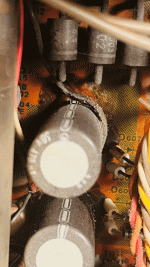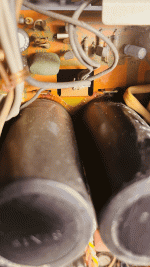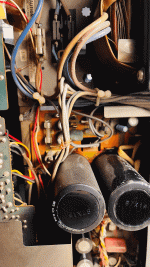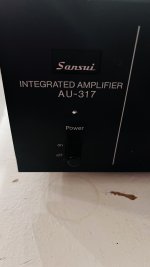I have noticed a lot of threads about repairing older units and advice about not paying too much for them because they might need recapping either right away or soon.
My amp (Sony TA-F450ESD) is from about 1980. It sounds fine to me but I can't say my ears are in top shape so was wondering..............
What would be the noticeable signals that would indicate it is time to reach for the soldering iron?
My amp (Sony TA-F450ESD) is from about 1980. It sounds fine to me but I can't say my ears are in top shape so was wondering..............
What would be the noticeable signals that would indicate it is time to reach for the soldering iron?
cap failure:
Sight - signs include vented tops, swollen caps, oozing fluids, bubbling, green corrosion, and leaky under-seal.
Smell - may smell metalic, or sometimes acidic. May smell like rodent urine.
Feeling - Higher than expected temperature of the cap. Sometimes a cap will become partially detached.
Sound - Power supplies may whine harder with ripple changes. Output may start to produce artifacts.
Electrically - Measurement of microfarads may be off. Power supplies may strain, and possibly draw more current or produce non-expected voltages.
If any of the above, then consider replacing the caps. Especially leaking ones.
Otherwise, play on
Sight - signs include vented tops, swollen caps, oozing fluids, bubbling, green corrosion, and leaky under-seal.
Smell - may smell metalic, or sometimes acidic. May smell like rodent urine.
Feeling - Higher than expected temperature of the cap. Sometimes a cap will become partially detached.
Sound - Power supplies may whine harder with ripple changes. Output may start to produce artifacts.
Electrically - Measurement of microfarads may be off. Power supplies may strain, and possibly draw more current or produce non-expected voltages.
If any of the above, then consider replacing the caps. Especially leaking ones.
Otherwise, play on
Last edited:
I have a Sansui AU-317-11 ,bought it second hand at a car-boot sale 25 years ago cheaply , use it for my flatscreen audio via a multisat box and Tannoy floorstanding loudspeakers --and guess what ?? still works fine ,never even changed one capacitor.
This made me look it up on the web and one website gave it 5-stars --old as it is.
This made me look it up on the web and one website gave it 5-stars --old as it is.
Yes, I have two HK-430 receivers from the 70s that were giveaways, and other than the expected wear on
the controls (which I bypassed), they work like new. We use them for hours every day for background music.
the controls (which I bypassed), they work like new. We use them for hours every day for background music.
WIthout taking the cover off, hook it up to a speaker of the rated ohms. 4 ohms for those power ratings, 8 ohms for those. Speakers read 25% lower on ohms scale of DVM than impedance (which includes inductance).
Find a highly compressed sound source, like a pop/rock radio station. Turn up til it sounds a little funny, then back off a little. (clipping). Read the voltage on speaker with an analog VOM, a RMS capable DVM, or a scope. Average voltage is 70% of peak to peak reading of scope. I've found $30 DVM produce random numbers on music. Cheap DVM are accurate only on 50 or 60 hz on AC V scale. $39 analog VOM are usually fine for this. Check analog VOM calibration with wall AC voltage if you don't trust it.
P=(V^2)/Z where Z is speaker impedance.
Power equals rating, you have no problem yet.
Power << than rating, you have dried up mains caps.
Internal coupling cap dry-out can cause loss of treble or bass depending on design. I listen to piano CD's for the standard sound, but I have good ears & know what a Steinway piano sounds like. (I own one mounted between the speakers).
I usually find the amp sounds "polite" on classical music, before I do the power test. No peaks on ff passages in orchestral performances, drum hits or piano pings sound same as everything else. You have to listen to classical music a lot to miss those variations.
Guitars, electronic instruments, voice, etc, the sound tech was paid to make those sounds unique. You have no idea what the track sounded like at mastering time. Guitars electric bass & voice have no frequencies over 7000. Classical, the instruments have a standard sound. When condensor mikes started being used ~1964, classical recordings started approaching the sound of the real instruments. Ribbon mikes weren't even close.
Find a highly compressed sound source, like a pop/rock radio station. Turn up til it sounds a little funny, then back off a little. (clipping). Read the voltage on speaker with an analog VOM, a RMS capable DVM, or a scope. Average voltage is 70% of peak to peak reading of scope. I've found $30 DVM produce random numbers on music. Cheap DVM are accurate only on 50 or 60 hz on AC V scale. $39 analog VOM are usually fine for this. Check analog VOM calibration with wall AC voltage if you don't trust it.
P=(V^2)/Z where Z is speaker impedance.
Power equals rating, you have no problem yet.
Power << than rating, you have dried up mains caps.
Internal coupling cap dry-out can cause loss of treble or bass depending on design. I listen to piano CD's for the standard sound, but I have good ears & know what a Steinway piano sounds like. (I own one mounted between the speakers).
I usually find the amp sounds "polite" on classical music, before I do the power test. No peaks on ff passages in orchestral performances, drum hits or piano pings sound same as everything else. You have to listen to classical music a lot to miss those variations.
Guitars, electronic instruments, voice, etc, the sound tech was paid to make those sounds unique. You have no idea what the track sounded like at mastering time. Guitars electric bass & voice have no frequencies over 7000. Classical, the instruments have a standard sound. When condensor mikes started being used ~1964, classical recordings started approaching the sound of the real instruments. Ribbon mikes weren't even close.
Last edited:
So apart from visible faults, foul smells, and out of range meter readings I'm still in good shape. I recently finished building my new speakers and started listening to a lot of different stuff, both analogue and digital sources. I have to say I have reached the point of not lusting after anything further up the ladder. I'll just keep my eyes and ears peeled for any signs of deterioration.
You could add a woofer fuse and forget about it. The other drivers will have series capacitors that block DC.
I've replaced ~600 caps that didn't smell, leak, or look bad. 2 watts on the speaker from a 100 w Allen organ amp, a Hammond organ that sounded like a soft kazoo with no string bass or attack instead of the premium product shipped in 1967 (77 capacitors in that), a ST70 that went "polite" about every 7 years. Vacuum tube products can also have tired tubes, but transistors usually work, fail or make pops.
If i were u, i wouldnt do anything, unless there is a critical fault.
If you want to try something out, then switch to different AC sockets = change distance between AMP box and PREAMP/SOURCE/Computer box😉
If the system is "ON" for a longer time without "ON/OFF" interruption, it will get better.
If you want to try something out, then switch to different AC sockets = change distance between AMP box and PREAMP/SOURCE/Computer box😉
If the system is "ON" for a longer time without "ON/OFF" interruption, it will get better.
I've got an old 1972ish HK 330A receiver, changed a few caps in it, but many are still just fine.
Lovely sounding receiver it is.... but then again, it's Harman Kardon!
A little "tweaking" can make some difference in some cases, just be judicial and use your head.
Lovely sounding receiver it is.... but then again, it's Harman Kardon!
A little "tweaking" can make some difference in some cases, just be judicial and use your head.
Look at page 5 in manual 😀
Lol, this page is about equalize, line and poweramp section.
There is also a table on the same page which contains strange data on EU / West Germany model.
What model do you have ? UK, EU or West Germany...
Why do you want suddenly to recap anything, you feel something not cool ?
Lol, this page is about equalize, line and poweramp section.
There is also a table on the same page which contains strange data on EU / West Germany model.
What model do you have ? UK, EU or West Germany...
Why do you want suddenly to recap anything, you feel something not cool ?
Most of us who are new to electronics will stumble across "recapping" threads at almost any audio forum. Judging by the time spent on crafting wordy tales of choosing parts and suppliers there, it must be a kind of initiation rite for those with little understanding but who want to improve their audio systems or just to perform what they believe will be preventive maintenance.
So they spend money and time on something they enjoy but probably have no idea of whether their gear already measures up to other, comparable systems and is in tip-top condition anyway. "Day and night" differences are often claimed after recapping but I suspect (having done these recaps many times myself) that much of this is an expectancy effect, exaggerated by the lapse of time between auditions, though there can be some truth to the effect of just changing the brand or grade from one type to another, when you compare high priced boutique audio types, long-life industrials, different shape and size, cheapo quality, high temp. rated or just a respected brand and grade suggested for audio use.
There are differences in measureable cap. qualities such as ripple current/ESR ratings that can make big differences to sound quality as power is increased but let's hope you read these specs and compared before making a choice based only on the brand, voltage and capacitance ratings. A DMM can't do this, so if you want to check caps for age-related qualities, you have to use a capable ESR meter.
So they spend money and time on something they enjoy but probably have no idea of whether their gear already measures up to other, comparable systems and is in tip-top condition anyway. "Day and night" differences are often claimed after recapping but I suspect (having done these recaps many times myself) that much of this is an expectancy effect, exaggerated by the lapse of time between auditions, though there can be some truth to the effect of just changing the brand or grade from one type to another, when you compare high priced boutique audio types, long-life industrials, different shape and size, cheapo quality, high temp. rated or just a respected brand and grade suggested for audio use.
There are differences in measureable cap. qualities such as ripple current/ESR ratings that can make big differences to sound quality as power is increased but let's hope you read these specs and compared before making a choice based only on the brand, voltage and capacitance ratings. A DMM can't do this, so if you want to check caps for age-related qualities, you have to use a capable ESR meter.
Hi
I have an AU-317 in what appears to be "not too bad" shape.
I got it for free from a friend and I am considering using it as a project to learn abit more about electronics and soldering and such (I have a friend who knows what he is doing who will help me)
The amp sounds ok to my ears but it has - what I would think is - a low AC hum. It is quite audible to me when no sources are playing.
It appears to be unaffected by volume pot or any other controls. My friend says that it might always have been there (he has had it 25years+)
Upon visual inspection, the 2 largest caps and the 6 smaller ones (470µF) looks leaky.
However, the noise goes away when I disconnect the power-stage from the pre-stage by removing the pre/power jumper, leading me to question if replacing the big leaky caps will solve the problem as those caps appear to belong to the power-stage?
Any thoughts on what the culprit might be or if my line of thought is sound at all? 🙂
Does it make sense to try and specify the cause of the noise before doing anything else or would you recommend at least replacing the leaky caps?
I am looking at a 39 nichicon cap upgrade kit at 39€ from audio-high-store.
Any help or advice is much appreciated 🙂





I have an AU-317 in what appears to be "not too bad" shape.
I got it for free from a friend and I am considering using it as a project to learn abit more about electronics and soldering and such (I have a friend who knows what he is doing who will help me)
The amp sounds ok to my ears but it has - what I would think is - a low AC hum. It is quite audible to me when no sources are playing.
It appears to be unaffected by volume pot or any other controls. My friend says that it might always have been there (he has had it 25years+)
Upon visual inspection, the 2 largest caps and the 6 smaller ones (470µF) looks leaky.
However, the noise goes away when I disconnect the power-stage from the pre-stage by removing the pre/power jumper, leading me to question if replacing the big leaky caps will solve the problem as those caps appear to belong to the power-stage?
Any thoughts on what the culprit might be or if my line of thought is sound at all? 🙂
Does it make sense to try and specify the cause of the noise before doing anything else or would you recommend at least replacing the leaky caps?
I am looking at a 39 nichicon cap upgrade kit at 39€ from audio-high-store.
Any help or advice is much appreciated 🙂





Is this a series II?
https://www.hifiengine.com/manual_library/sansui/au-317.shtml
Replacing the leaky 10,000uF capacitors in the power amplifier section is fine, but the 470uF in the preamp section
may be the cause of the hum. There are also a few more in the preamp supply, 100uF and 47uF.
Probably they should all be replaced. Work on them one pair at a time. First the 470uF, then the 10,000uF,
and then the rest.
If possible, first practice soldering and desoldering on a junk board to get some practice and to avoid damaging the amp.
https://www.hifiengine.com/manual_library/sansui/au-317.shtml
Replacing the leaky 10,000uF capacitors in the power amplifier section is fine, but the 470uF in the preamp section
may be the cause of the hum. There are also a few more in the preamp supply, 100uF and 47uF.
Probably they should all be replaced. Work on them one pair at a time. First the 470uF, then the 10,000uF,
and then the rest.
If possible, first practice soldering and desoldering on a junk board to get some practice and to avoid damaging the amp.
Is this a series II?
https://www.hifiengine.com/manual_library/sansui/au-317.shtml
Replacing the leaky 10,000uF capacitors in the power amplifier section is fine, but the 470uF in the preamp section
may be the cause of the hum. There are also a few more in the preamp supply, 100uF and 47uF.
Probably they should all be replaced. Work on them one pair at a time. First the 470uF, then the 10,000uF,
and then the rest.
If possible, first practice soldering and desoldering on a junk board to get some practice and to avoid damaging the amp.
I think it is a mk1

I will practice a bit as we have vast amounts of old electronics laying around.
I have access to high-quality tools for measuring outputs as well, I am in the process of scouring this forum to soak up the needed knowledge 🙂
Next up will be getting rid of Noys on my Wurlitzer organ and on my holfi power8/pre8.

I will practice a bit as we have vast amounts of old electronics laying around.
I have access to high-quality tools for measuring outputs as well, I am in the process of scouring this forum to soak up the needed knowledge 🙂
Next up will be getting rid of Noys on my Wurlitzer organ and on my holfi power8/pre8.
Looking at a capacitor and suspecting it to be "leaky' is unprofessional nonsense.
Unless there is a definite fluid leakage around the cap, not glue which in some cases is used to anchor heavy caps.
There is no visible way to suspect a bad cap unless it has blown itself up. - a clearly opened-up popped top or seal. (not the damn "bulged top cap" that people seem to worry about. - that is normal plastic deformity.
So PLEASE people, listen to me, and use a meter or signal tracer to troubleshoot a hum problem in electronics.
It's the ONLY positive way to locate an issue.
And if you don't have test equipment, you should not even go about guessing things, that's something a fool would do.
Unless there is a definite fluid leakage around the cap, not glue which in some cases is used to anchor heavy caps.
There is no visible way to suspect a bad cap unless it has blown itself up. - a clearly opened-up popped top or seal. (not the damn "bulged top cap" that people seem to worry about. - that is normal plastic deformity.
So PLEASE people, listen to me, and use a meter or signal tracer to troubleshoot a hum problem in electronics.
It's the ONLY positive way to locate an issue.
And if you don't have test equipment, you should not even go about guessing things, that's something a fool would do.
That is not a leaky capacitor. That is the glue used by the manufacturer to hold down the capacitor. You might want to remove the glue since they will already or eventually become corrosive.Upon visual inspection, the 2 largest caps and the 6 smaller ones (470µF) looks leaky.
Average voltage is 70% of peak to peak reading of scope.
Average voltage by the RMS method is 70.7% of peak voltage. Not peak to peak. And only for sine waves.
- Home
- Amplifiers
- Solid State
- When to recap?